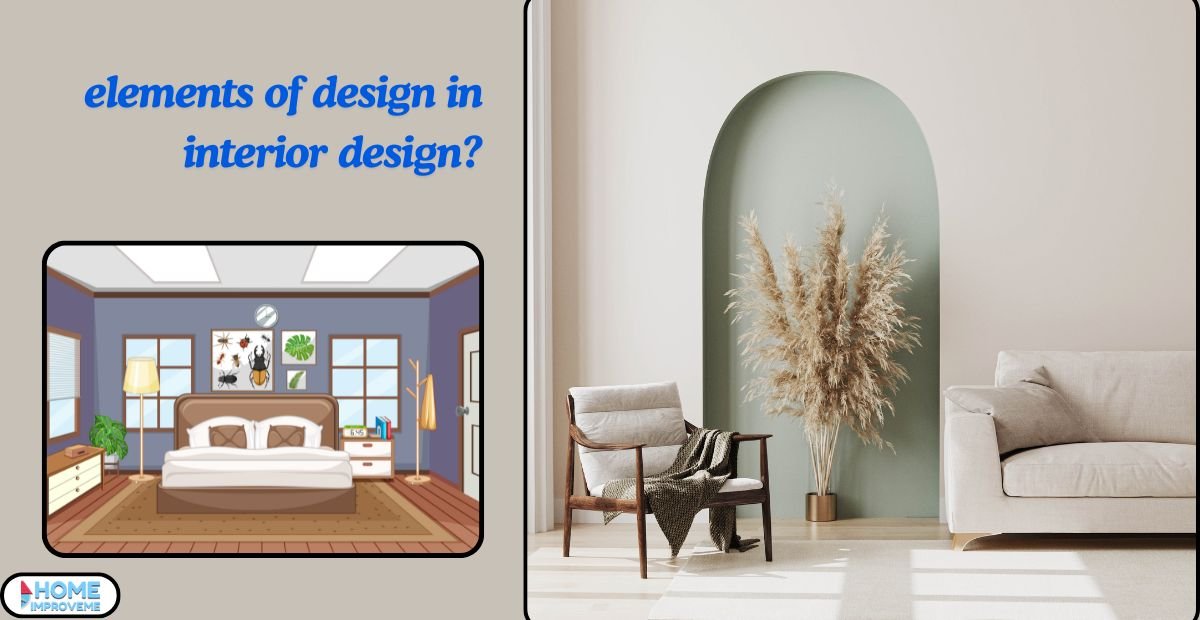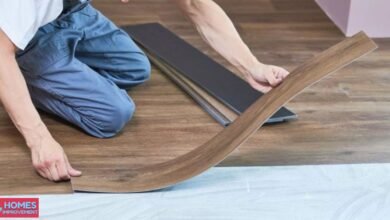What are the elements of design in interior design?

Functionality and beauty are the main goals of interior design. The achievement of that ideal equilibrium depends critically on a number of important factors. These components add vitality and balance to a space.
Anyone, from a professional designer to a home decorator, can plan and create a room that feels just right by having a basic understanding of these ideas.
Let’s explore What are the elements of design in interior design.
How many elements are there in interior design? Top 10 elements (elements of design in interior design)
Space
Definition of Space: A room’s actual bounds are referred to as its space. When decorating, this is the space you have to work with.
Types:
- Positive Space: The portions of a room that have objects, such as furniture, décor, and other items, are known as positive spaces.
- Negative Space: The empty spaces in a room devoid of any things.
Significance: Maintaining a balance between positive and negative space is essential to avoid the area feeling overly packed or devoid. The proper combination gives the space a cozy, welcoming appearance and feel.
Line
Definition of a Line: In interior design, lines direct the viewer’s gaze. They aid in defining the shape of a space and emphasizing key features.
Types of Lines:
- Horizontal: These lines provide a feeling of solidity and serenity and are frequently connected to furniture like tables and beds. They perform best in areas intended for unwinding, such living rooms and bedrooms.
- Vertical: Features like windows, entrances, and tall furniture can create these lines. A space appears larger and more expansive when there are vertical lines added to it, which provide height and openness.
- Dynamic: A space is given vitality and movement by dynamic lines, such as curving, zigzag, or diagonal lines. They are frequently utilized to provide visual interest and excitement to artwork, patterned fabrics, and stairs.
Application: Lines can add visual interest, define spaces, and create forms. By directing the viewer’s eye throughout the space, well-used lines can define distinct zones within a room, shape the architecture, and add to the overall aesthetic and feel.
Form
Definition: Form is the arrangement of shapes that give a room structure and character.
Types:
- Geometric: Geometric shapes include squares, rectangles, and circles; they are symmetrical and structured forms. They give a space a feeling of predictability and order.
- Organic: These forms resemble the flowing water or the curved surfaces of plants because they are organic and free-form. They bring in a softer, cozier atmosphere.
Interaction: Forms should balance a room’s lines and general style. Forms provide harmony and visual intrigue in a place when they complement existing lines.
You can better appreciate how effective interior design changes any space if you are aware of these components. Recall that every component—including form—is essential to providing a response to the query, “What are the elements of design in interior design?”
Light
Definition of Light: Light affects our perception of a place, its shades, and its general temper, making it an vital aspect of interior layout. Natural light and artificial light are the two primary sorts of mild to remember.
Natural Light: Sunlight that is available in thru windows, skylights, or other openings is referred to as natural mild. Natural light is vital due to the fact it could alternate the appearance of colours, enhance mood, and deliver the impact that a area is greater and more inviting.
Artificial Light: Electric lights which are used in place of or similarly to herbal light to create illumination at some point of the night time.
There are three main types of artificial light:
- General Lighting: Often known as widespread lights, it guarantees visibility and safety through supplying a room with popular illumination.
- Task Light: This type of lights is supposed for specialized regions utilized for responsibilities like running, studying, or cooking. Desk lamps, studying lamps, and kitchen lighting under shelves are a few examples.
- Accent Lighting: Accent lighting is employed to attract attention to precise layout elements, which include indoor flora, artwork, or architectural details. This kind of lights gives a room drama and visible attraction.
Balance: The secret to designing spaces that are both useful and visually beautiful is to skillfully combine natural and artificial light. A room’s overall design will be improved and comfort levels raised with the correct balance. For instance, translucent drapes can help regulate how much natural light enters a space, and carefully placing lamps can guarantee that some sections are well-lit without being overly bright.
Any place may be transformed by knowing how to use light appropriately, ensuring that it functions well for daily tasks and looks nice.
Color
Role: Color’s role in interior design: Color has a profound effect on perception, mood, and the general atmosphere of a room. The selection of appropriate colors can create a feeling of coziness, vibrancy, or calmness in a space, as well as alter the perception of space.
Color Schemes:
- Monochromatic: This color scheme combines several tones, tints, and hues of the same hue. Because there aren’t any striking contrasts, it works well for establishing a unified and tranquil aesthetic.
- Similar: This scheme makes use of hues that are adjacent to one another on the color wheel, such green and blue. Most of the time, these pairings are aesthetically pleasant and harmonious.
- Complementary color: schemes mix hues that are in opposition to one another on the color wheel, such as orange and blue. It produces a vivid, high contrast image that helps bring out the details.
Considerations:
- Impact of Light: Color appearance is greatly influenced by lighting. Artificial light can alter the hue and intensity of a color, whereas natural light highlights the true color. Thus, before making a final choice, it’s imperative to try to paint colors in different lighting settings.
- Space Size: Color selection can change how big a space looks. Dark hues can create a feeling of coziness and intimacy, whereas light colors tend to make a space feel bigger and more airy.
- Colors’ Psychological Effects: Emotions are evoked differently by different hues. Red, on the other hand, can invigorate and stimulate, while blue can produce a peaceful and serene atmosphere. Designing a setting that supports the intended mood and function can be made easier by having an understanding of the psychological effects of color.
Texture
Definition: Texture refers to an object’s surface nice inside a space. It is probably visible (how something appears to sense) or tactile (how something feels to the touch).
Tactile Textures: Textures that you can experience immediately are called tactile textures. Brick or wool are examples of tough surfaces, and glass or metallic are examples of easy surfaces.
Visual Textures: Textures which can be perceived visually are called visible textures. They give off the appearance of getting a particular texture even while you aren’t touching them. For example, despite the fact that an image of a rocky surroundings is clean, it could appear rough.
Usage: Layering diverse textures collectively in a room can supply its intensity and interest. An ecosystem may be made to experience well-balanced and fascinating through combining stylish metals with woven fabric or by combining easy and rough surfaces.
Pattern
Definition: A pattern is when decorative elements, including lines, forms, and colors, are used repeatedly in a design. Patterns may create harmony in a space and offer visual interest.
Types:
- Stripes: These are parallel lines that can have different widths to give them distinctive appearances.
- Floral patterns: Those with floral and botanical motifs that lend a soothing, natural feel.
- Geometric shapes: These include squares, triangles, and circles; they give a room a clean, contemporary vibe.
- Abstract: More amorphous and non-representational patterns that frequently have a creative and artistic quality.
Impact: By directing the viewer’s attention and establishing the room’s style, patterns aid in establishing a room’s rhythm and flow. When used carefully, they may bring the various design components together, giving the whole thing a sense of coherence and purpose.
Balance
Definition: In interior design, balance refers to how visual weight is distributed throughout a space to engender harmony and stability. Balance comes in three primary forms: symmetrical, asymmetrical, and radial.
Types of Balance:
- Symmetrical Balance: A room achieves symmetrical equilibrium when the elements on one side of it mirror those on the other. A good illustration of symmetrical balance is when two chairs are placed side by side around a table. A balance like this seems professional and structured.
- Asymmetrical Balance: When components on either side of a room differ yet nevertheless seem balanced, this is known as asymmetrical balance. For instance, a collection of tiny objects on one side could counterbalance a massive piece of furniture on the other. This balance has a more relaxed, lively vibe.
- Radial Balance: Elements organized around a central point are said to be in radial equilibrium. Imagine a round table with chairs positioned all around it. This kind of equilibrium, which is frequently seen in living rooms or dining rooms with a central focal point, directs attention to the center.
Function: Every kind of balance contributes to the visual stability and harmony of a space. The formality and tradition that come from symmetrical balance are apparent. A room feels livelier with asymmetrical balance’s addition of movement and curiosity. By creating a focal point in the middle of the space, radial balancing promotes interaction and dialogue.
Regardless of the room’s style, understanding these many forms of balance can assist create environments that feel comfortable and well-organized.
Proportion and Scale
Proportion: This describes how various items relate to one another in a given space. It has to do with how harmoniously various furniture, accessories, and other components fit together. For instance, the unbalanced proportions of a huge sofa and a little coffee table may look strange.
Scale: The size of an object in relation to the room’s total area is known as its scale. It’s critical to check that everything fits properly in the space that it’s in. A tiny artwork on a vast wall may appear inconsequential, but a massive chandelier in a small room may feel overwhelming.
Purpose: The basic objective of comprehending scale and proportion is to make sure that every element in a room is scaled and arranged such that it appears balanced and coherent. This improves the room’s aesthetic appeal and comfort. Everything seems perfectly in place and the space appears harmonious when the scale and proportion are correct.
Rhythm
Definition: In interior design, rhythm is the recurrence of visual components to evoke movement in a room. It facilitates the eye’s easy transition from one place to another.
Techniques:
- Repetition: Repetition is the practice of using an element repeatedly in a space. For instance, you may arrange multiple pillows that match on a couch or use curtains, rugs, and cushions all in the same design.
- Progression: Progression is the process of progressively changing the dimensions of related items. One way to arrange candles could be to place them in a row, tallest to shortest.
- Alternation:Using two or more pieces in a regular pattern is known as alternation. A design that alternates between two colors, such as a checkerboard pattern made of tiles, is one example.
- Contrast: To create visual interest, use components that contrast significantly with one another. This can involve combining many textures, colors, and shapes in one area.
Outcome:
The primary objective of rhythm is to direct the viewer’s gaze in a fluid, flowing way throughout a space. When done well, it creates a sense of harmony and coherence in a room, which results in an aesthetically beautiful and dynamic interior design.
FAQs
Which component of interior design is the most crucial?
In interior design, there isn’t a single most significant component because every component is vital to the creation of a pleasing and useful place. Nonetheless, it’s common knowledge that balance, proportion, and color are fundamental elements that greatly influence a room’s overall appearance and functionality.
What typical errors in interior design can one avoid?
Overdecorating, disregarding scale and proportion, and prioritizing style over functionality are examples of common errors. Avoiding bad lighting is also crucial because it has a big impact on how a room looks and functions. Always have a thorough plan and consider the functional as well as aesthetic components of your design.
What are the 5 most important elements of interior design?
The 5 main elements of interior design are:
- Space: The area to be designed, including the room’s dimensions.
- Form: Shapes within the space, such as furniture and décor.
- Light: The use of lighting to illuminate and enhance the room.
- Color: Shades and hues used to create an atmosphere.
- Texture: The surface quality of objects, which can add depth and interest.
What is the element form in interior design?
In interior design, an object’s shape and structure inside a space are referred to as its element form. Geometric forms, such as squares and circles, are symmetrical and structured, whereas organic forms are more organic and free-form. The form must blend in nicely with other design components to produce a unified and eye-catching appearance.
Conclusion
We have discussed in detail What are the elements of design in interior design?
The diverse discipline of interior layout combines technological know-how and art to create places which might be both aesthetically lovely and beneficial. Balance, share, rhythm, concord, and other essential concepts may be understood and incorporated with the aid of designers to create spaces that are not handiest aesthetically desirable but additionally purposeful and appropriate to the wishes and tastes of the humans occupying them.
The atmosphere and functionality of a room are further improved by the deliberate use of elements like color, texture, pattern, and light. Successful interior design is ultimately about bringing personal style and comfort together to create a unified and welcoming space.




